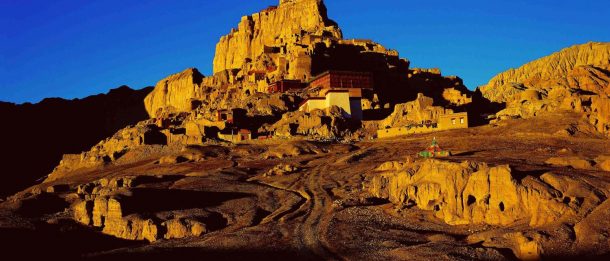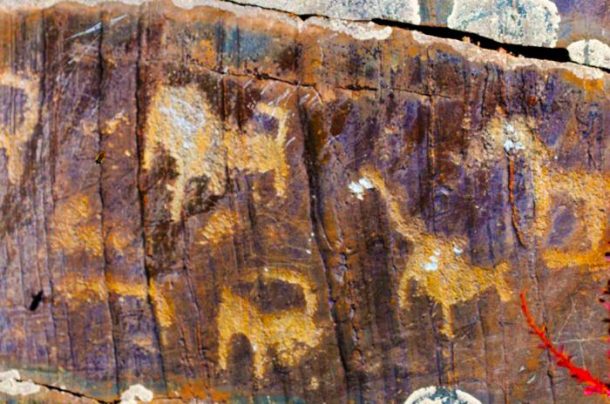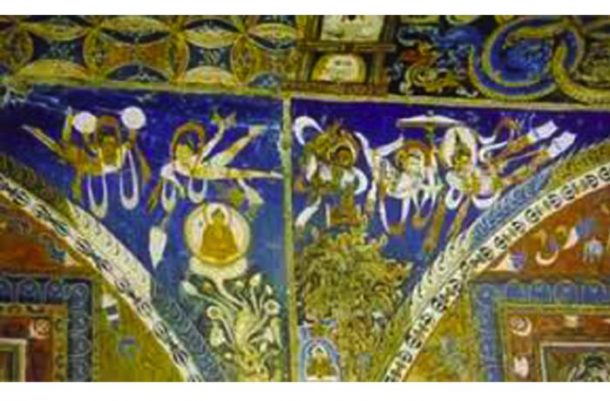The Ancient Artworks of Western Tibet
While most of Tibet came under the influence of the Tibetan Kings during the 7th and 8th centuries, a large area of the region on the roof of the world was held by other kingdoms. Vast stretches of the plateau in the modern-day Ngari Prefecture were once home to the ancient kingdoms of Guge and Shangshung, and evidence can still be found today of their existence, mostly in the ruins of the architecture and the amazing artworks that have survived for more than 1,000 years.

This region of western Tibet is not only the home of ancient kingdoms that were separate from the Tubo Kingdom of Tibet but is believed to be the home and birthplace of the ancient Bon religion, the original religious belief of the Tibetan plateau that predates Tibetan Buddhism by more than 15,000 years. And it is this ancient religion in these ancient western kingdoms that produced some of the most amazing artworks in Tibet.
Table of Contents
Rutog Rock Paintings
In the far northwest of Tibet, in Rutog County of Ngari Prefecture, there lies some of the most amazing ancient rock paintings in the world. Known as the Rutog Rock Paintings, the artworks can be found in more than a dozen places across the county, the most popular site being along the edges of the famous Pangong Tso, known in China as Bagong Co.
The rock paintings in Rutog County consist of engraved images of religious rituals, hunting, herding, and farming, as well as images of the sun and moon, the mountains, and animals such as yaks, horses, sheep, donkeys, antelopes, and people. Believed to have come from the ancient Shangshung Kingdom, which predated the Tubo Kingdom and Guge Kingdom of Tibet by more than 1,000 years, these ancient rock carvings and paintings are an important piece of Tibetan history, and one of the earliest forms of writings in Tibet.

Over the past few decades, many of these ancient carvings and paintings have been discovered across Rutog County, as well as in Gerze and Ge’gyai Counties, some of them at elevations that it was not previously believed the ancient Tibetans could survive in. The intrinsic artistic value of the paintings is immeasurable, yet not well understood, and it is not even known exactly how old the carvings are.
Donggar Frescoes
In the vast stretches of western Tibet lies Donggar Village, a small settlement in Zhada County of Ngari Prefecture. Here lies another of the ancient artworks of Tibet, known as the Donggar Frescoes. Believed to be one of the first examples of Buddhist art in Tibet, these cave paintings are found in just two simple grottoes near the villages of Donggar and Piyang, which lies just a kilometer apart. The largest known Buddhist cave painting sites in the world, these grottoes are one of the biggest cultural mysteries of Tibetan Buddhism, since no records exist of the cave paintings, which are located halfway up a mountain.
The craftsmanship of the paintings is exquisite, and were created using smooth, well-knit lines and forms, with unique designs in bright colors. The images contain figures of Buddha, and many of the frescoes depict the legendary life of Buddha and the stories of Buddhism. Other images also include paintings of the bodhisattvas, the protectors of Dharma, as well as images of animals and birds, and even of men worshipping the Living Buddha.

The wide universe described in the Mandala paintings in the caves is both figurative and colorful, and while the main images are always Buddhist in nature, there are paintings within the caves that show how well-traveled the Buddhists of western Tibet were. As well as the usual paintings of Buddha and the Apsara, there are also paintings of foreign animals such as lions, sheep, horses, wild geese, and elephants, as well as images of dragons and two rising phoenix.
Within the grottoes, it has been discovered that there are caves for different uses. The most exquisite paintings can be found in the caves that were used for worship, while the caves for the monks to live in, and those for storage, and are less colorful and exotic in their designs. The paintings are, amazingly, in excellent condition, considering their age, comparable to the paintings in the caves at Dunhuang, and it is widely believed that the minerals used in the paint is the secret to their resistance to the effects of time.
The Ancient Artworks- Guge Frescoes
Far out in western Tibet, there was once a kingdom spawned from the ruins of the ancient Tubo Kingdom of central Tibet. Known as the Guge Kingdom, this ancient kingdom in the west was centered on Zhada County, and was founded during the 10th century, with its main cities in Tholing and Tsaparang.
Now in ruins, the Guge Kingdom, which covered a vast area of western Tibet, as well as parts of Ladakh in India, is one of the most important cultural sites for ancient artworks in Tibet. The site of the former Red Palace and White palace contains some of the most spectacular frescoes in Tibetan Buddhism, which have stood the test of time for more than 1,100 years.
This small, but important, kingdom in western Tibet is one of the most culturally important sites for Tibetan Buddhism, as it was a haven for Buddhists at the time when the religion was on a downturn after the death of the Tibetan king, Songtsen Gampo. Inside the palaces, the walls are covered with artistic decoration and frescoes, which depict both religious and cultural instances. The frescoes have many examples of religious subject matter, including hundreds of images of Buddha, the bodhisattvas, and the Apsara, which are surrounded by images of ordinary people.

The images of the ordinary people include depictions of farming, from ploughing and sowing to harvesting, hunting, and milking, and are more delicate than the rough yet entrancing paintings of the Donggar Frescoes. The main colors of the Guge Frescoes are predominantly red, yellow, and orange, which show up well in the stark contrast with the dark green and black rock of the caves.
While the Guge Frescoes may be the most recent of the western artworks of Tibet, they are just as important to the Tibetan culture as the oldest Shangshung-era paintings and carvings in the rocks of Rutog County. For Tibetan archaeologists, who are only now discovering that the plateau was inhabited more than 15,000 years before it as previously believed, these ancient frescoes and rock carvings show a timeline of Bon and Buddhism in Tibet that helps to date the ancient history of the Tibetan ancestors.
Recent Posts
The Ultimate Guide to Tibet Tours, Travel, and Trekking Adventures
How to Explore Tibetan Culture
Exploring Lhasa:The Heart of Tibet
All Categories
- About Tibet
- book a Tibet tour
- Buddhism Practice
- Budget Tour
- China-Tibet Train
- Customized Tibet tour
- Historical Sites
- Hot Springs in Tibet
- News
- Photography in Tibet
- Tibet attraction
- Tibet Group Visa
- Tibet Motorcycle Tour
- Tibet Small Group Tours
- Tibet Tours and Tibetan Tour Guide
- Tibet Train
- Tibet Travel FAQs
- Tibet Travel Information
- Tibet Travel News
- Tibet Travel Permit Update
- Tibet Travel Prices Rises
- Tibet Trek
- Tibet Trekking Tour
- Tibet weather and climate
- Tibet Wildlife animals
- Tibet Winter Tour
- Tibetan Buddhism
- Tibetan Cultural Features
- Tibetan Culture and Poeple
- Tibetan Festivals
- What to see in Tibet



